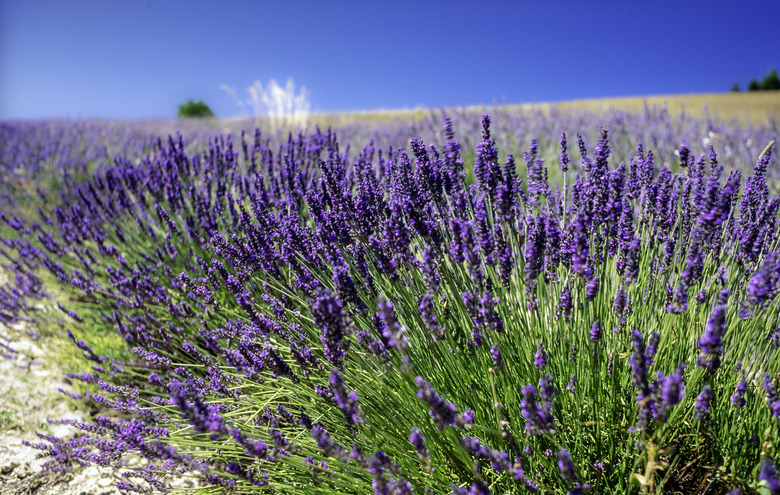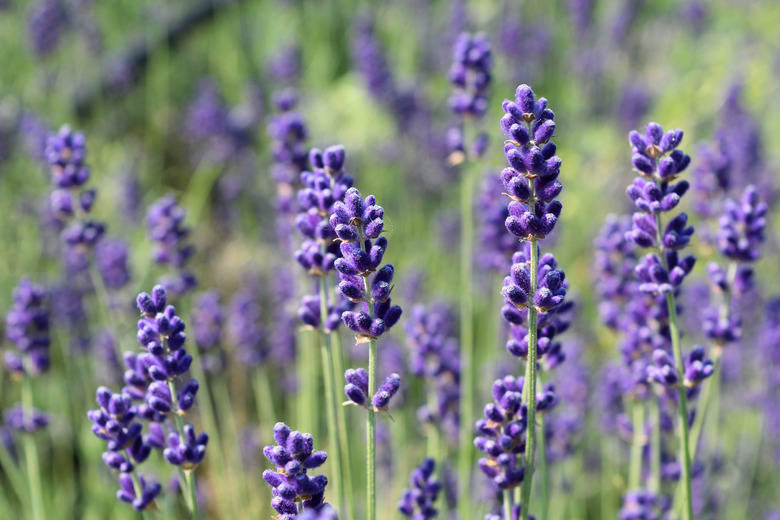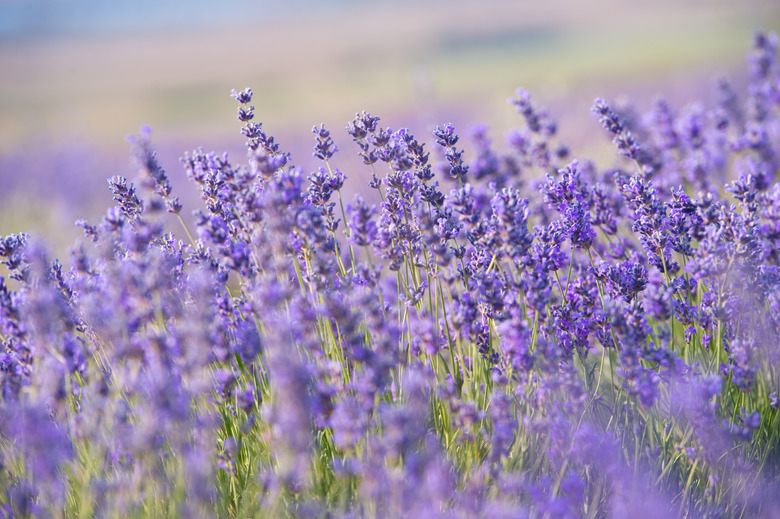How To Grow Lavender
We may receive a commission on purchases made from links.
If you're ever on Instagram, you've probably seen photos of influencers lounging among lavender fields. You can almost smell the fragrant blossoms through your screen. Did you know that it's possible to grow lavender plants (Lavandula spp.) in your own garden? You don't need to travel miles to the nearest lavender farm to enjoy the scent of this flowering perennial.
Lavender comes from the warm, arid regions of Africa, Asia, India and the Mediterranean. One of the most common types of lavender is English lavender, or Lavandula angustifolia (USDA hardiness zones 5-8). It is a plant with fragrant, spiky foliage topped with — you guessed it — lavender-colored flowers, though some types of lavender have blue-tinged or dark-purple flowers.
The pretty, pollinator-friendly plant blooms primarily in the summer. It's also a relatively easy plant for home gardeners to master. If you're searching for a low-maintenance plant that will help attract beneficial insects to your garden, lavender is an excellent choice.
Best Uses for Lavender
Best Uses for Lavender
There are plenty of good reasons to consider adding lavender to your garden. It's relatively easy to grow and makes a great addition to drought-prone spots in your yard (e.g., landscaping under eaves) or areas with poor soil (e.g., rock gardens). The woody perennial grows to a maximum of 3 feet in height, so choose it if you need to fill a bare area in your garden's middle ground.
Landscaping With Lavender
People often stick lavender in herb gardens, but its attractive foliage is visually appealing enough to garner it a prominent place in the flower garden even when not in bloom. You can use it as a short border plant where appropriate too. Plant lavender in masses for a more dramatic effect. Because lavender has cool-toned leaves, it looks good paired with vibrant green foliage.
You can grow lavender in containers or directly in the ground. Flanking your entrance with large, potted lavender plants makes for a stunning porch display. Potted lavender is also a popular patio plant because its pungent smell helps repel bugs like mosquitoes. Munstead lavender is an English cultivar that's ideal for containers because of its compact growth habit. Make sure to use containers with drainage holes like Mkono plastic planter pots to prevent accidental root rot.
By planting lavender in the ground along paths and walkways, you can enjoy the scent as you pass by. Lavender also attracts a variety of beneficial insects, which makes it an excellent candidate for edible gardens.
Wellness Benefits of Lavender
You can snip the plant and enjoy its summer blooms indoors. Lavender also has a host of potential health benefits. Rarely does an essential oil set come without a bottle of lavender oil. Studies suggest that lavender may help with stress and anxiety. Some people use the soothing scent to help them fall asleep. Essential oil enthusiasts who wish to extract oil from lavender plants should opt for a variety like Lavandin (Lavandula x intermedia, zones 5-8). This hybrid plant typically produces more flowers with high yields of oil.
The perennial herb is also frequently used to make a variety of bath and body products because of its strong scent. There's some evidence that lavender oil may help with alopecia-related hair loss and various skin conditions. Another study concludes that lavender may have anti-inflammatory properties, which helps explain its ability to soothe and calm irritated skin.
Cooking With Lavender
You can also cook with lavender, though not everyone loves the strong flavor of the herb. It's commonly used in baking and pairs well with lemon. It adds a floral aroma to baked goods but isn't quite a good fit for savory dishes. If you plan to use lavender in your culinary creations, the best types to choose are those with a sweet aroma, such as Provence lavender (Lavandula x intermedia 'Provence'). If you're a fan of lavender's scent, you can also dry sprigs of it and add it to sachets to make homemade potpourri.
How to Grow Lavender
How to Grow Lavender
How to Start Lavender From a Seedling
How to Start Lavender From a Seedling
Many nurseries offer lavender seedlings in the spring along with other popular herbs. Look for young plants that are healthy and pest-free. Seedlings will take time to grow, but this route is much easier than starting from seed.
While tender seedlings do best planted in the spring once there's no longer a risk of frost, you can plant larger, more mature plants in the fall. Do so several weeks before the first expected frost to give the plant roots a change to establish themselves.
When planting, keep plants at least 2 feet apart. Mulching can help keep weeds down. Avoid "wet" mulch like wood chips as you're better off using rocks or gravel to mulch around lavender. Wetter mulch types allow for too much moisture around plant roots and can encourage root rot.
In What Zone Does Lavender Grow Best?
In What Zone Does Lavender Grow Best?
Most types of lavender grow best in USDA plant hardiness zones 5 through 9. It can deal with poor soil but needs full sun to thrive. Avoid planting lavender in areas of your yard where water pools (e.g., near pools, near ponds, below hills and under gutter drainage). Planting lavender close to larger structures (e.g., trees, hedges or your home) can help provide shelter in the winter.
If you live in a climate with hot, humid summers, rock mulch can help combat some of that humidity and can keep your lavender plants happy and dry. Keep plants far enough apart so that there's good air circulation between them, especially in humid climates.
In zone 4 and colder, it may not be possible to overwinter lavender outdoors, so plant the fragrant bush in containers. You can ensure they get plenty of sun throughout the summer and then move them indoors when chillier weather comes along.
Grosso lavender (Lavandula x intermedia 'Grosso') is a great cultivar to plant if you live somewhere with freezing winters and hot summers. The hybrid lavender combines heat tolerance with cold hardiness. It's also an excellent producer of oil.
When Should You Plant Lavender?
When Should You Plant Lavender?
Plant lavender in the spring but wait until the soil is warm enough to work and all chance of frost has passed. You won't have much luck digging into the earth if it's partially frozen, after all. If you're not sure whether it's warm enough or not, wait until your last frost date has passed, and then wait another two weeks just to be sure.
In the fall, plant well enough in advance so that newly planted lavender can establish itself. Roots need some time to grow before a hard freeze.
Soil, Sunlight and Water Recommendations for Lavender
Soil, Sunlight and Water Recommendations for Lavender
Lavender will be perfectly happy hanging out in soils with low fertility, but you can't skimp on sunlight. Lavender needs at least six hours of full sunlight per day and the more, the better. Since lavender prefers alkaline soil, you'll also want a soil pH of at least 7.0.
Lavender is also drought-tolerant, so it does well in rock gardens or as an edging plant along pavement. It's native to warm, arid climates, so it prefers dry locations. Rocks, for instance, help reflect heat and keep roots dry by encouraging good drainage.
Water up to twice a week during the first few weeks after planting to help the lavender become established. After that, watering every few weeks will do. Once the plant is flowering, increase waterings once a week if there's no rainfall. Too much water can be a death sentence for lavender plants, so always pay attention to rainfall. During a week of heavy rain, you don't need to water.
If you bring potted lavender inside for the winter, water infrequently. The plant won't need as much water during the cold months since it will be in dormancy mode.
How to Propagate Lavender
How to Propagate Lavender
Propagating plants is one of the cheapest ways to populate a garden. If you already have one plant or know someone who does, you can propagate cuttings to get multiple whole new plants. Just make sure you're not propagating a patented cultivar. This is an illegal practice, whether you're propagating for personal or commercial use.
To propagate lavender:
- Cut a branch that doesn't have any buds or blossoms. Cut deep enough so that you get at least an inch of the woody stem.
- Remove the lower leaves from the piece of branch.
- Dip the fresh cutting in a store-bought rooting hormone.
- Place the dipped cutting into a sterile seed-starting or potting mix.
- Water every day, keeping the soil moist.
- Transplant outdoors once the plant has several sets of leaves, weather permitting. Don't forget to harden off any plants you start or propagate indoors.
How to Winterize Lavender
How to Winterize Lavender
In zones 5 through 9, lavender should survive the winter just fine. In zones 4 and colder, you may be able to overwinter lavender if you plant it close to the southern sides of walls or structures.
If you're having trouble keeping lavender alive through the winter, the issue may be too much moisture. Make sure to plant lavender away from areas where water tends to pool. You can also cut flower stalks before winter sets in to help move your lavender plant into dormancy mode. In colder climates, plant lavender in pots and bring them inside when it starts to get frosty.
How to Harvest Lavender
How to Harvest Lavender
If you want to harvest lavender to put flowers on display, cook with it or make bath-time creations, it's as easy as snipping the flower stalks when at least half of the flower buds are open.
Cut the flower stem above the junction where new growth, leaves or buds are starting to form. This allows the side leaves to continue producing flowers. You can get away with clipping off more of the stem with larger plants.
Dried or fresh, lavender flowers make a beautiful addition to cut flower bouquets. If you're interested in capturing the strong scent of lavender, harvest flower spikes in the morning.
Common Pests and Other Problems for Lavender
Common Pests and Other Problems for Lavender
Lavender doesn't have very many natural pests. The biggest threat to lavender is excess moisture. To avoid root rot, don't overwater.
Lavender plants can also become leggy if you don't prune regularly. Prune your lavender plants once a year when new growth emerges in the spring. You can tell the growth is new because it will have a green coloration. Prune as much as a third of the top of your plant (for larger, more mature lavender bushes) to keep it from getting too woody and leggy. Pruning helps maintain a nice, bushy aesthetic. Prune less if your plant is young or compact. Use sharp, clean gardening shears like the gonicc 8-inch professional premium pruning shears to prune your lavender plants.
Common Diseases for Lavender
Common Diseases for Lavender
Most fungal diseases are the result of too much water or humidity. Leaf spot is one such fungal infection that sometimes plagues lavender plants. Fungicides can help prevent the spread of fungal diseases like this one, but it won't cure them.


